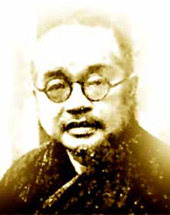Views
Tàixū 太虛 (1890-1947)
|
Notable Associates:
|
|
Tàixū 太虛 (1890-1947)
Tàixū was one of the most influential and well-known Chinese Buddhist figures of the modern era, a reformer who established seminaries and Buddhist periodicals, such as his long-running Hǎicháo yīn 海潮音.
Biography
Tàixū was born in northern Zhèjiāng 浙江 province in 1890. His father, a bricklayer, died when he was only a year old, and when his mother remarried his maternal grandmother took care of him. He received a primary education in the Chinese classical learning, and from the age of eight accompanied his grandmother on pilgrimages to sacred mountains in eastern China. In 1901 he was apprenticed to a business in Chángān town, but the death of his mother and health problems of his own prevented him from fulfilling his professional responsibilities.[2]
In 1904, when Tàixū was fourteen, he decided to enter the Buddhist sangha and was tonsured at a small temple in Sūzhōu 蘇州 where he was given the dharma name Wéixīn 唯心 (mind-only). He was later given the style name by which he is most widely known, Tàixū, and later that year took the full precepts at Tiāntóng Temple 天童寺 in Níngbō 寧波 under the monk Jìchán 寄禪. He went on to train at Yongfeng Temple, practicing Chan meditation and engaging in sūtra study. The Śūraṅgama Sūtra (Lèngyán jīng 楞嚴經) and the Lotus Sūtra (Fǎhuá jīng 法華經) were especially attractive to him.[3] It at this time that Tàixū first met Yuányīng 圓瑛, the start of a productive but difficult friendship. In 1907 Tàixū had an enlightenment experience while reading the Mahaprajnaparamita Sutra 大般若波羅蜜多經, and he would later recall that after this his studies became much easier, as if the insights were coming from his own heart.[4]
Tàixū's reformist thinking was influenced early on by Huáshān 華山, whom he met in 1908.[5] Huáshān had already been involved in monastic educational and organization reform in response to the "Build Education with Temple Property" movement 廟產興學. Under Huáshān's influence and later that of Qiyun, Tàixū was exposed to revolutionary philosophical and political works by authors such as Kāng Yǒuwéi 康有為, Liáng Qǐchao 梁啟超, Zhāng Tàiyán 章太嚴, and Sun Yat-sen 孫中山.[6]
His "revolutionary" activities would begin in 1912 when he and Rénshān 仁山 collaborated on a plan to take over Jīnshān Monastery 金山寺 in Zhènjiāng 鎮江 and use its resources to establish a modern school for monastics 僧學堂. The so-called "Invasion of Jinshan" 大鬧金山 failed, but the incident established Tàixū's reputation as a revolutionary monk. Tàixū came to epitomize the radical changes feared by conservatives and supported by more progressive members of the Buddhist community.[7]
Important Works
- Lectures in Buddhism. Paris: Les Amis de Bouddhisme, 1928.
- 佛學的將來 (The Future of Buddhism), 1935.
- 法相唯識學 (Dharmalakṣaṇa and Consciousness-Only), 1938.
- 護國言論集 (Collected Speeches on Protecting the Nation), 1939
- 太虛大師全書 (The Complete Works of Venerable Taixu), 20 Vols., 1956.
- 整頓僧伽制度論 (On Reorganizing the Monastic System), 1958.
Notes
- ↑ Luo Tongbing connects Tàixū to this pen name in a forthcoming volume
- ↑ Pittman, 63-65.
- ↑ Pittman, 66.
- ↑ Ritzinger, 4; Pittman, 67.
- ↑ For more on Huáshān, see Shì Dōngchū 釋東初. Zhōngguó Fójiào jìndài shǐ 中國佛教近代史 (A History of Early Contemporary Chinese Buddhism), in Dōngchū lǎorén quánjí 東初老人全集 (Complete Collection of Old Man Dongchu), vols. 1-2. Taipei: Dongchu, 1974: Vol. 2, pp. 887-889.
- ↑ Pittman, 67-69.
- ↑ Pittman, 74-77; Welch 28-33.
References:
- Hamilton, C. H. "An Hour with T'ai-hsü, Master of the Law." The Open Court. 42 (1928): 162-169.
- Pittman, Don A. Toward a Modern Chinese Buddhism: Taixu's Reforms. Honolulu: University of Hawai'i Press, 2001.
- Ritzinger, Justin R. "Taixu: To Renew Buddhism and Save the Modern World". Master's Thesis, available at [1].
- Shì Dōngchū 釋東初. Zhōngguó Fójiào jìndài shǐ 中國佛教近代史 (A History of Early Contemporary Chinese Buddhism), in Dōngchū lǎorén quánjí 東初老人全集 (Complete Collection of Old Man Dongchu), vols. 1-2. Taipei: Dongchu, 1974 Pp. 2.805-811.
- Shì Tàixū 釋太虛. Tàixū dàshī quánshū 太虛大師全書, 10 vols. Beijing: Zongjiao wenhua chubanshe, 2005.
- Shì Tàixū 釋太虛, ed. Fǎxiàng wéishì xué 法相唯識學. Beijing: Shangwu yinshuguan, 2002. Originally published in Chángshā 長沙, c. 1938.
- Yú Língbō 于凌波, ed. Xiàndài Fójiào rénwù cídiǎn 現代佛教人物辭典 (A Dictionary of Modern Buddhist Persons), 2 vols. Taipei: Foguang, 2004. Pp. 1.95b-97c.
